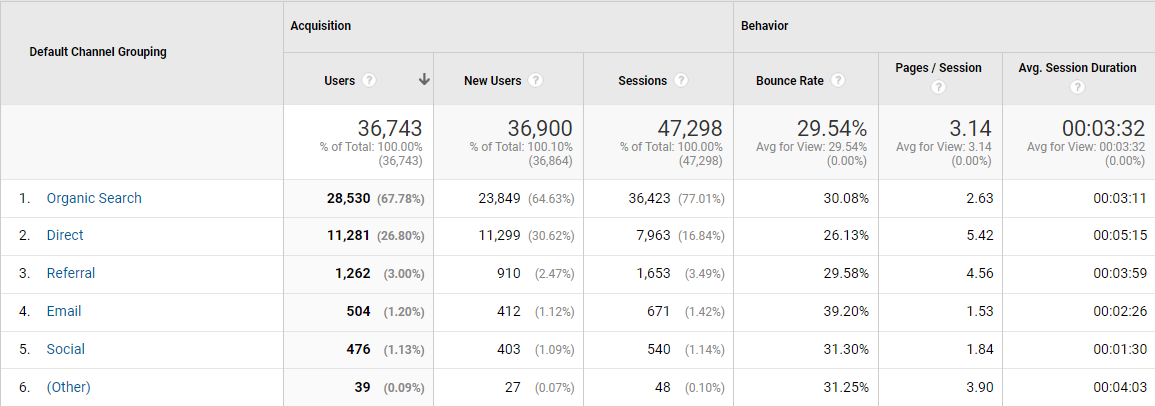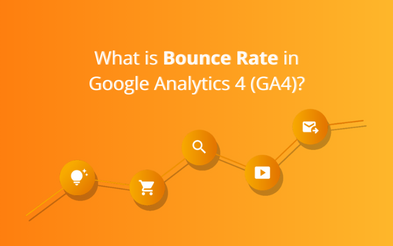Bounce rate is a metric that measures the percentage of single-page sessions on a website or app. In Google Analytics 4, the bounce rate is calculated differently than in Universal Analytics (UA). In GA4, the bounce rate is the percentage of sessions that were not considered engaged. This means that if someone viewed a single page and spent less than 10 seconds on that page or didn’t convert, then the session would be considered a bounce.
When calculated using this approach, the bounce rates of many websites are likely higher than anticipated. Analyzing bounce rates across various industries reveals the following patterns:
- Landing pages: Experience a 70-90 percent bounce rate.
- Retail websites: Tend to have a 20-40 percent bounce rate.
- Content websites: Exhibit a 40-60 percent bounce rate.
- Lead generation websites: Show a 30-50 percent bounce rate.
These figures provide insights into the engagement levels of different types of websites.
How to Calculate Bounce Rate in GA4
In GA4 (Google Analytics 4), the bounce rate is now determined as the complement of the engagement rate. To clarify, the GA4 bounce rate represents the proportion of sessions that lacked engagement.
As defined by Google, engaged sessions within GA4 fulfill one or more of the following criteria:
- Duration surpasses 10 seconds.
- Includes a conversion event.
- Encompasses a minimum of 2 page views.
To calculate the bounce rate in GA4, divide the number of bounces (non-engaged sessions) by the number of sessions and multiply by 100. For example, if a website had 100 sessions and 60 of those sessions were bounces, the bounce rate would be 60%.
Why Did Google Change the Definition of Bounce Rate in GA4?
The reason why Google changed the definition of bounce rate in GA4 is that the traditional or Universal Analytics version of bounce rate has become less useful as an analytics metric. It provides a diminishing level of measurement of engagement as websites have evolved to become more interactive and dynamic.
Where to Find Bounce Rate in GA4
In the older Universal Analytics, the bounce rate was shown in nearly all reports related to website traffic. Here’s an example you can see in the screenshot below:

Bounce Rate
But in GA4 bounce rate is not found in Standard format, to get it on the dashboard you’ll need to customize the report
First, log in to Google Analytics and go to Reports on the left side. Just so you know, you should be an Editor or Administrator to tweak reports.
Locate the report you wish to change, and then select Customize Report at the top right.
After that, click on Metrics under Report Data.

Bounce Rate
Comparing Bounce Rate in UA vs. GA4
The bounce rate in GA4 is quite different from the bounce rate in UA. In UA, bounce rate has been the percentage of sessions that contain a single page view on a website. In GA4, the bounce rate is the percentage of sessions that were not considered engaged.
Other Metrics to Consider
While bounce rate is an important metric to track, it should not be the only metric used to measure website or app performance. Other metrics to consider include:
-
Engagement Rate:
This is the percentage of engaged sessions on a website or app. An engaged session is a session that lasts longer than 10 seconds, has a conversion event, or has at least 2 pageviews or screenviews.
-
Exit Rate:
This is the percentage of sessions that ended on a particular page. Unlike bounce rate, exit rate takes into account all sessions that ended on a particular page, regardless of whether they were single-page sessions or not
-
Time on Page:
This is the amount of time that visitors spend on a particular page. It can provide insights into how engaging a page is for visitors
By tracking these metrics along with bounce rate, website owners and digital marketers can gain a more comprehensive understanding of user behavior and website performance.
Conclusion
Bounce rate is an important metric to track in Google Analytics 4 as it measures the percentage of single-page sessions on a website or app. While the definition of bounce rate has changed in GA4, it is still a valuable metric to track. By also tracking engagement rate, exit rate, and time on page, website owners and digital marketers can gain a more comprehensive understanding of user behavior and website performance. As a Google Analytics expert, it is important to stay up-to-date with changes in GA4 and to use these metrics to inform digital marketing strategies. If you are looking for a digital marketing agency or SEO agency in Mumbai to help you with your website or app analytics, consider reaching out to a reputable agency for assistance.


